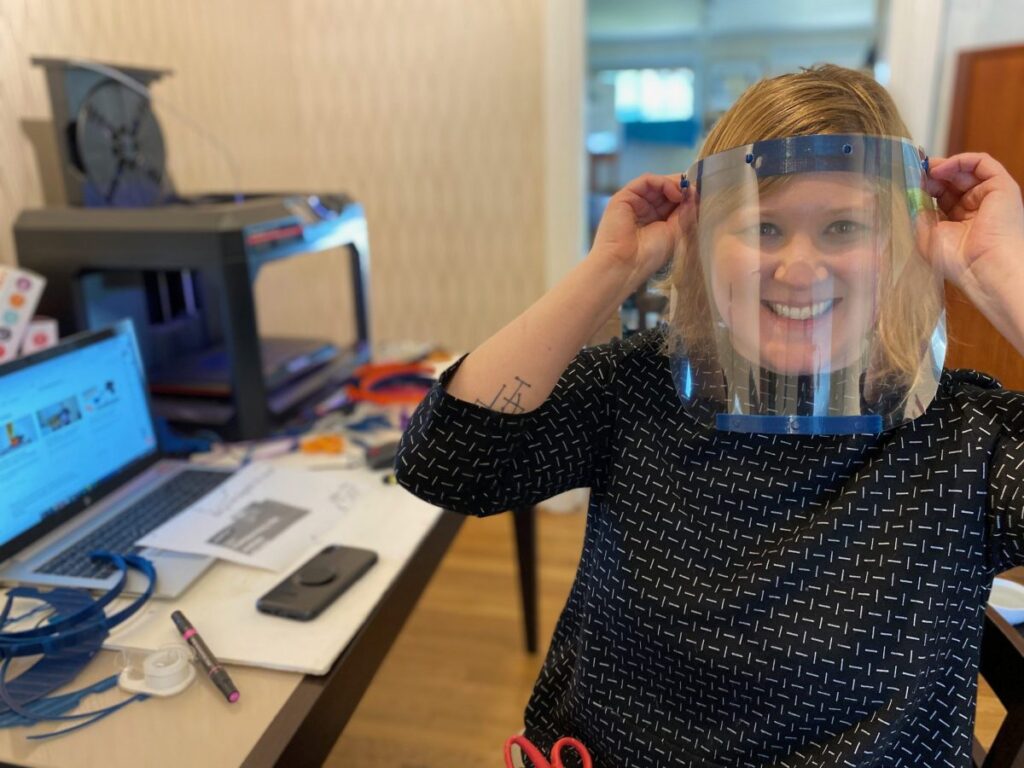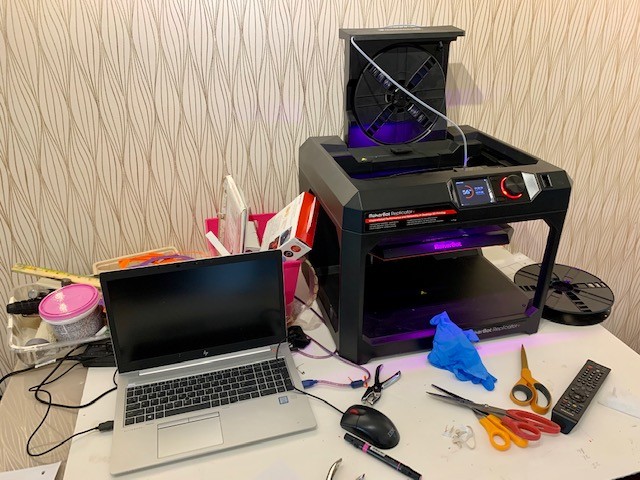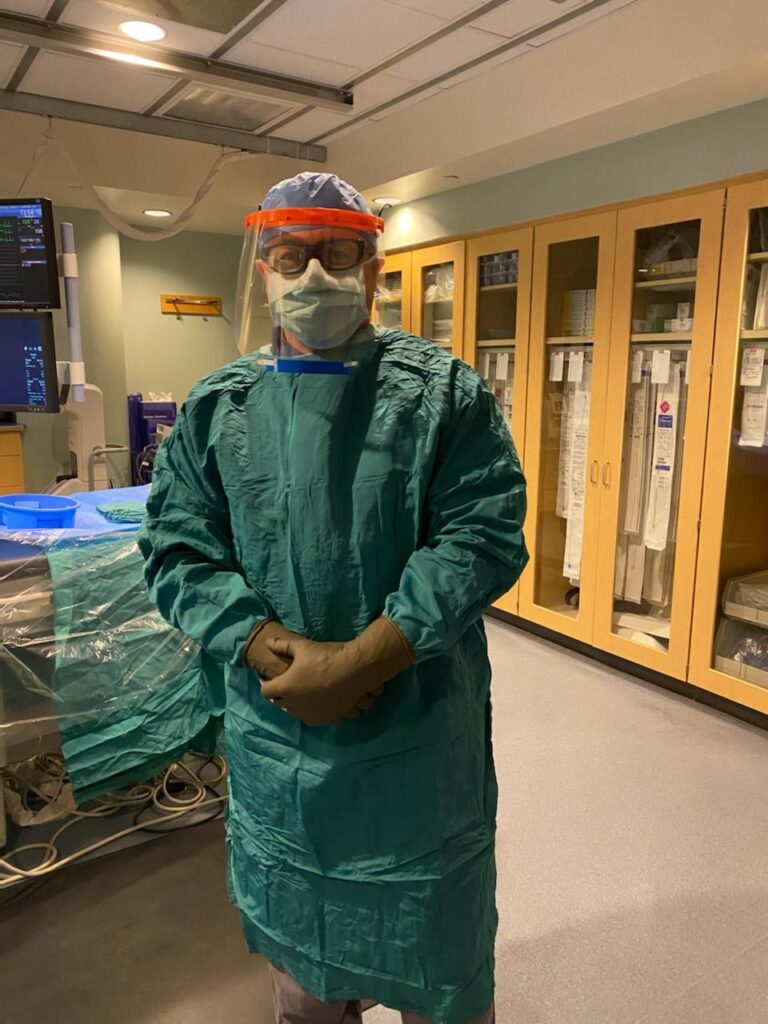The lack of adequate personal protection for frontline healthcare workers has been a major failure of our national preparation for the COVID-19 pandemic. Sarah Heller, an art educator at The Lexington School in Lexington, Kentucky, decided to join in the efforts to find solutions to the shortage of PPE by developing a prototype for face shields which would offer a higher degree of protection in healthcare settings. As part of the maker movement, Sarah brought technical skills and capabilities and the requisite can-do attitude to this vital project. She responded in writing to questions. Her account of the project and also its implications for how and what we teach our children is a path into a future where art education becomes absolutely basic and essential.

How did you get the idea to develop a face shield prototype?
I woke up on March 25th at 5 A.M. to a blast of text messages from Dr. Sylvia Cerel who was on a mission to find a resource from all who had technology to get involved in aiding the PPE crisis locally. I know her directly from being a parent at The Lexington School and she knew I had a 3D printer in my classroom. She gave me the spark to research and get involved. It became my greatest challenge as to how I could use my small classroom printer to create a prototype device for making face shields. How can one person with a small 3D printer have any effect?
Process: A.) Identify the need. How can a rapid prototype fill a need for PPE supply? B.) What’s out there in the Maker Space world as far as open source files and designs being shared? C.) Spend time to evaluate, test, fail and find a model that could work. D.) Modify, understand the limitations of open source file; what does design need to move forward based on design, 3D printing limitations, and resources? How do we ultimately find a 3D print file that is a prototype that can be shared for all to get up and running?
What technical knowledge and abilities did you bring to the project and what tools do you have at your home that enabled you to implement it? What materials did you have to source?
I’m blessed with an unconventional background as a licensed architect and artist. I’m a creative designer with high technical skills who understands how the prototype process works. This defines what ‘Makers’ are. We understand technology, current machines, and how to push new ideas forward.
My current role as an elementary art teacher at The Lexington School allows me to teach 5th graders the fundamentals of 3D printing with a Makerbot Replicator+ in my classroom. It keeps me in touch with trends and equipment, and ultimately prepares this generation with a technology that will impact every aspect of the workforce they will enter. When I got Sylvia’s call about a dire situation and current crisis for PPE, I literally grabbed my classroom printer, filament, and support materials and set it up in my dining room. My primary goal was to create a prototype to be shared.
What started as a small idea to create a working prototype for a PPE shield in my dining room grew into something I could never have imagined.

Did the open source prototype files that you accessed need modifications?
To be clear, I’m not creating an original design of my own: I’m examining the uploads of other designers from around the world, testing, and modifying to a need – and that’s the process of makers and prototyping. The beauty of this process is ALTRUISM. The file I’ve taken on to redesign and modify is the one I will, in return, upload to the original creator as a modification to share. Designs that work can be immediately uploaded and pushed further. The model I decided was the best to work with is from Prusa Research, a company in the Czech Republic. I took their open source file and had to make modifications based on metric differences and material reinforcement. Ultimately the greatest challenge is to find a 3D printed model that can be printed in a reasonable time. It is a SLOW process to 3D print which is the greatest barrier most 3D printers face.
How long did it take you to develop the prototype and were there others with expertise that worked with you on the development process?
This has been a breakneck challenge for me as a designer and I worked by myself initially to test and develop a design. I have the added benefit of being teacher at The Lexington School and to have strong support for research and development to push new maker technologies. When I woke up to the call from Sylvia Cerel, I contacted the head of The Lexington School and discussed the project. She immediately dedicated our equipment, resources, and material to sponsor this research to develop a prototype.
The beauty of open source files in the Maker World is that the design options and file sources are infinite. You look to find a design that is most applicable to you, but as a designer you must take on that design and customize it to your own needs. It’s a process of test and fail – just like any innovation process. I often quote Thomas Edison to my students, “I have not failed. I’ve just found 10,000 ways that won’t work.” Makers all over the world are challenging designs at breakneck speed. If Edison uploaded one open source file on a light bulb, I guarantee we as designers around the world would react and redesign. Thomas Edison only needed to upload one light bulb design to makers and there would be a maker’s response within a day that would make the perfect light bulb.
To take one idea with a small classroom printer to develop a prototype that has been shared internationally blows my mind.
The New Victory Gardens: 3D Printing May Save Lives from The Lexington School on Vimeo.
Has the prototype been used in small-scale manufacturing locally? Globally? Is there a feedback process to perfect the design?
Simply put, there has not been time to go through normal testing and manufacturing and I don’t claim to be an expert of manufacturing. This is a prototype file that I’m sharing and supporting. Due to the immediate crisis of PPE shortage the grassroots efforts of people sewing masks, gowns, and making shields has been at the level of the WW2 victory gardens. Members of the community are making and delivering aid in the moment to help healthcare providers in this major health crisis.
This one shield prototype I’m working on has been given to local nurses, doctors, and hospitals just as a test. I’m not within my means with a small printer to be a source of production. The protoype developed has been modified based on feedback and I continue to share the 3D printed file as it evolves to other makers in the community. I’ve received inquiries about the file from India, Germany, Brazil and the United States from many architecture firms who want to help. Community partners we’re working closely with are Newton’s Attic/Dawn Cloyd and Grey Construction/Robert Lownes. The file has traveled and I’m here for technical support and feedback.

Do you see larger implications of this kind of project for the Maker Movement and for education?
Absolutely. I currently teach 5th graders 3D printing at The Lexington School and we are gearing up to build our own MakerSpace at TLS to apply to Middle School as curriculum. This is 21st century education and I believe a Design/Thinking mentality is one of the most essential components to early education. Teaching innovation begins with critical thinking skills and empathy. I was jolted out of bed with a need, looked at the resources I had, and worked to find a solution with resilience and creativity. What I’m going through right now is the exact process I’ll teach, and I can’t think of a better teachable moment. I’m excited as a teacher to share my direct experience in a moment of crisis and how the maker movement and design can save lives. I’m also not afraid to show them my failures in the process. For me to share first-hand experience and use this as an example of solving an immediate crisis, I can’t think of more priceless way to educate on how one person can design with technology from a dining room table. The Makers are our future.
Are you planning other prototyping projects?
I’m not pursuing more projects. My passion for research and development couldn’t ignore this great urgency of protecting our healthcare heroes. It’s so difficult right now to sit by and watch this world unfold as it is. Altruism is my driving force. It’s a word I can’t live without and I’m always happy to collaborate with that drive to push innovation in causes such as these.
Photo images courtesy of Sarah Heller.




